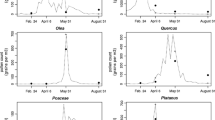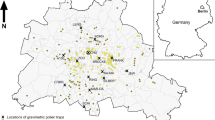Abstract
Persistent allergies are common in workers in florist shops but little research has been done on the reasons for this. This paper reports an investigation of occupational exposure of florists to pollen and spores in three florist shops over a 2-week period in the autumn of 2000. In each shop three sampling methods were used: Burkard continuous volumetric samplers, deposition plates and low-tac tape for surface samples, including hands of the florists and leaves of a selection of the plants. The florists kept a record of the type of work they undertook each day and of the stock amounts of flowers in the shops. The volumetric traps collected 80 pollen and spore taxa. The average concentrations recorded through the working day were generally low but short-term peak (one hour mean) concentrations of some types were found to be relatively high or very high. For a few taxa these concentrations equalled or exceeded those typical for short-term peaks in wind dispersed pollen types in the ambient air. Fungal spore concentrations of several known allergenic types were also very high for peak periods. This was most notable for Aspergillus spp. which reached extremely high concentrations in one shop, compared with typical peak concentrations in the ambient atmosphere. Low-tac tape leaf samples demonstrated that the flowers' foliage is a major source of the fungal spores. Few pollen grains or fungal spores were found on the hands.
Similar content being viewed by others
References
Adams R. M., Daily A. D., Brancaccio R. R., Dhillon I. P. and Gendler E. C.: 1990, Alstroemeria. A new and potent allergen for florists. Dermatol. Clin. 8, 73–76.
Bangha E. and Elsner P.: 1996, Occupational Contact Dermatitis toward Sesquiterpene Lactones in a Florist. Am. J. Contact Derm. 7, 188–190.
Bethea L. K., Schuman S. H., Smith-Phillips S. E. and Kelly J. W.: 1988, South Carolina florists 'dermatitis: case report and survey results. J. S. C. Med. Assoc. 84, 446–448.
Bleumink E., Mitchell J. C., Geismann T. A. and Towers G. H.: 1976, Contact hypersensitivity to sesquiterpene lactones in Chrysanthemum dermatitis. Contact Dermatitis 2, 81–88.
Eriksson N. E., Lowhagen O., Nilsson J. E., Norrlind K. and Wihl J. A.: 1987, Flowers and other trigger factors in asthma and rhinitis-an inquiry study. Allergy 42, 374–381.
Goerz G., Wirth G., Maas B. and Willuhn G.: 1985, Allergic contact dermatitis due to Asteraceae (Compositae). Cross reaction with Liatris spicata [Article in German ]. Derm. Beruf. Umwelt. 33, 95–98.
Hausen B. M., Ketels-Harken H. and Schulz K. H.: 1976, Occupational allergy due to inhalation of pollen from Euphorbia fulgens Karw [Article in German ]. Dtsch. Med. Wochenschr. 101, 567–570.
Marks J. G. Jr.: 1988, Allergic contact dermatitis to Alstroemeria. Arch. Dermatol. 124, 914–916.
Murray L.: 1997, Decorative plants. Pollen Monitor February 1997.
Pereira F.: 1996, Hand dermatitis in florists. Contact Derm. 34, 144–145.
Piirila P., Kanerva L., Alanko K., Estlander T., Keskinen H., Pajari-Backas M. and Tuppurainen M.: 1999, Occupational IgE-mediated asthma, rhinoconjunctivitis and contact urticaria caused by the Easter lily (Lilium longi florum )and tulip. Allergy 54, 273–277.
Piirila P., Keskinen H., Leina T., Tubasela O. and Tuppurainen M.: 1994, Occupational asthma caused by decorative. owers: review and case reports. Int. Arch. Occup. Environ. health. 66, 131–136.
Quirce S., Tabar A. I., Muro M. D. and Olaguibel J. M.: 1994, Airborne contact dermatitis from Frullania. Contact Derm. 30, 73–76.
Rycroft R. J.: 1996, Dermatitis in florists. Semin. Dermatol. 15, 83–86.
Schulz K. H., Hausen B. M., Walljhofer L. and Schmidt-Loffler P.: 1975, Chrysanthemum allergy. Pt. II: Experimental studies on the causative agents [Article in German ]. Arch. Dermatol. Forsch. 251, 235–244.
Spettoli E., Silvani S., Lucente P., Guerra L. and Vincenzi C.: 1998, Contact dermatitis caused by sesquiterpene lactones. Am. J. Contact. Dermat. 9, 49–50.
Thiboutot D. M., Hamory B. H. and Marks J. G. Jr.: 1990, Dermatoses among floral shop workers. J. Am. Academy Dermat. 22, s54–58.
Author information
Authors and Affiliations
Rights and permissions
About this article
Cite this article
Emberlin, J., Adams-Groom, B., Treu, R. et al. Airborne Pollen and Fungal Spores in Florist Shops in Worcester and in Bristol, UK: A Potential Problem for Occupational Health. Aerobiologia 20, 153–160 (2004). https://doi.org/10.1023/B:AERO.0000032952.99736.f5
Issue Date:
DOI: https://doi.org/10.1023/B:AERO.0000032952.99736.f5




